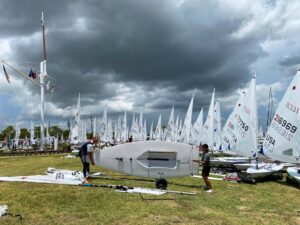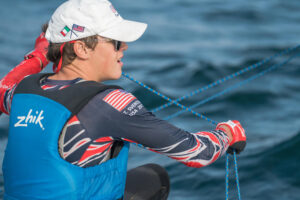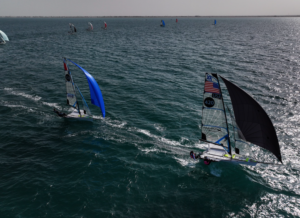 Junior sailors Connor Bennett, Ethan Sargent and Tor Svendsen got a taste of big-time competition when they recently competed in their first world championship regatta in the ICLA 6 at the Youth Worlds held in Houston, TX. Some two hundred kids from over thirty countries registered to race and in final results, Tor finished 52nd in Gold Fleet, while Ethan finished first in Bronze, just one point ahead of Connor.
Junior sailors Connor Bennett, Ethan Sargent and Tor Svendsen got a taste of big-time competition when they recently competed in their first world championship regatta in the ICLA 6 at the Youth Worlds held in Houston, TX. Some two hundred kids from over thirty countries registered to race and in final results, Tor finished 52nd in Gold Fleet, while Ethan finished first in Bronze, just one point ahead of Connor.
The boys, who are StFYC members and St Francis Sailing Foundation grantees, headed off to Texas in good company: Julian Soto, one of the country’s top Laser coaches, and Al Sargent, a regular competitor on the ICLA circuit (and Ethan’s dad). After collecting their charter boats, they tailored them with the gear that they brought from their boats back home. In ICLA regattas, most everything is chartered: the hull, mast, boom, daggerboard, and rudder which are standard components, while competitors bring their own sails, tiller, and lines since those tend to be more customized by each sailor.
Finally, boats were inspected to ensure that everything conformed to the strict ILCA rules that place an emphasis on the sailor and their skills, versus the quality of their equipment (note that the ILCA 6 is the medium-sized rig, with six square meter sail, bigger than the LCA 4 and smaller than the ILCA 7).
It was a hot, humid, very windy, and highly competitive regatta: overall, a grueling event as the local boys who raced attested. Day one was practice on Galveston Bay. Day two was a practice race, followed by a run to West Marine to upgrade control systems. Four days of racing followed, there was no sailing on day five due to lightning, and three races were sailed on day six.
At the conclusion of a three day “qualification series” where the sailors were randomly assigned to different fleets of about fifty-two boats each, competitors were then assigned to one of three fleets: Gold (top third), Silver (middle), Bronze (bottom third).
“It was good to make Gold Fleet and given it was my first World’s, I was happy with my result,” Tor noted. “It was a really windy regatta every day, six days of continuous hiking which was challenging. Many of the sailors competing were a lot bigger than me so I was struggling to keep up with them, but I was hiking hard and doing my best.”
Connor and Ethan duked it out in Bronze fleet right up until the final race of the final day.
“Connor came out strong, scoring two bullets and putting him into first place in Bronze with an eight-point lead over Ethan, in second,” Al Sargent said. “He had to only finish 13th or better in the last race. In the last race, Connor and Ethan were close to each other, but then Connor capsized, netting him a 14th place finish in the last race to Ethan’s 5th place.”
 Ethan Sargent, who has competed in the ICLA for the past four years commented, “It was the most competitive regatta in which I’ve competed, everyone was on their game and there was not one bad sailor.”
Ethan Sargent, who has competed in the ICLA for the past four years commented, “It was the most competitive regatta in which I’ve competed, everyone was on their game and there was not one bad sailor.”
Commenting on what he learned from racing with the best, Svendsen noted that physical fitness is key to sail the Laser at a high international level.
“I have lots of work to do on my fitness game,” he said, “and I also learned a lot about competing in big competitive fleets and how important being consistent is. You really must be big and strong, have endurance and hike really hard. You also have to be quick downwind. There were a lot of speed gains to be made downwind just because the waves were pretty big but there were also opportunities to overtake – if you were overtaking in waves successfully downwind then you could make a lot of gains. Also, starting in a big fleet on a crowded line you have to be really confident in your boat-handling as well as your acceleration and speed off the line.”
The boys also learned the importance of drinking plenty of water and eating properly given the heat and humidity, as temperatures throughout the regatta were in the high nineties, and winds consistently in the teens.
 “On land it was really hot, and you just had to stay hydrated and fueled,” Tor commented. “The competition was tough, but I learned a lot and just had a lot of fun just racing. We got to meet a bunch of people from around the world and from around the US which was really cool.”
“On land it was really hot, and you just had to stay hydrated and fueled,” Tor commented. “The competition was tough, but I learned a lot and just had a lot of fun just racing. We got to meet a bunch of people from around the world and from around the US which was really cool.”
On October 13, support clinics like the ODP, as well as talented sailors from all backgrounds who are working hard to follow their dreams, at St Francis Sailing Foundation’s Annual Auction event. Tickets are limited: be sure NOT to miss out and book online today at https://www.stfsf.org/.
The largest contribution to the Foundation came from the estate of member and Staff Commodore Tom Allen in his trust. Please consider a tax-deductible gift to the St. Francis Sailing Foundation in your will or trust. If you or your attorney needs information, call Treasurer Greg Meagher at 510-541-2543.
Results: https://jpvm.org/results/2022/ILCA6_Youth/results.htm
Photos: https://2022ilca6youth.ilca-worlds.org/photos/
Feature Image: (L to R) Tor Svendsen, Ethan Sargent, Connor Bennett / Credit Al Sargent
Other Images: Credit Event Photographers



 Happy to be racing on home turf this weekend in the
Happy to be racing on home turf this weekend in the 
 Getting to work with Chris was such an honor and an incredible learning experience. He brought a new level of expertise and professionalism that I will carry further into my campaign, and we plan to continue working together here and there throughout the next 2 years.
Getting to work with Chris was such an honor and an incredible learning experience. He brought a new level of expertise and professionalism that I will carry further into my campaign, and we plan to continue working together here and there throughout the next 2 years.

 “Both days had light breeze as we towed out, medium breeze as we started, and medium-heavy breeze halfway throughout the day,” Hamlin reported. “The breeze would start right-favored, then clock left throughout the day. Both days there was swell and chop, while the first day was more choppy, and the second had more swell. Both days had no current.”
“Both days had light breeze as we towed out, medium breeze as we started, and medium-heavy breeze halfway throughout the day,” Hamlin reported. “The breeze would start right-favored, then clock left throughout the day. Both days there was swell and chop, while the first day was more choppy, and the second had more swell. Both days had no current.”


 Post racing on the final day of the event, we were still determined to find a solution. We took measurements of the hull fittings and their positions to gather data points to compare to our hull in the US. Our American teammates were also helpful in lending their equipment for measurement sake in order for us to get to the bottom of our speed deficit. Another day went by and again we were the last 49er to de-rig our boat in an attempt to understand why the hull felt stuck in the water. We came home knowing we fought every moment to find a solution.
Post racing on the final day of the event, we were still determined to find a solution. We took measurements of the hull fittings and their positions to gather data points to compare to our hull in the US. Our American teammates were also helpful in lending their equipment for measurement sake in order for us to get to the bottom of our speed deficit. Another day went by and again we were the last 49er to de-rig our boat in an attempt to understand why the hull felt stuck in the water. We came home knowing we fought every moment to find a solution.
 14-year-old Mila Kane from San Francisco has been sailing for seven years and has been on the TISC race team for 3-4 years. Sailing is her favorite sport, and she was excited to race keelboats for the first time.
14-year-old Mila Kane from San Francisco has been sailing for seven years and has been on the TISC race team for 3-4 years. Sailing is her favorite sport, and she was excited to race keelboats for the first time.




























































 “It was super tight, fun racing. Different people won almost every day and it was just consistency, it wasn’t how big you won by on the days you won, it was when you didn’t win the day just how close you were. We went into the final day just three points ahead of Holtie, it was one of the tighter NAs that I have sailed.”
“It was super tight, fun racing. Different people won almost every day and it was just consistency, it wasn’t how big you won by on the days you won, it was when you didn’t win the day just how close you were. We went into the final day just three points ahead of Holtie, it was one of the tighter NAs that I have sailed.”
 Martin hails from Alexandria, VA, where he grew up sailing out of Annapolis on the Chesapeake Bay and sailed in college at Old Dominican University. In addition to his 11 North American victories, he has won four World Championships in the 505, the first in 1999 with Howie Hamlin, in Luberon, France.
Martin hails from Alexandria, VA, where he grew up sailing out of Annapolis on the Chesapeake Bay and sailed in college at Old Dominican University. In addition to his 11 North American victories, he has won four World Championships in the 505, the first in 1999 with Howie Hamlin, in Luberon, France.


 I am so grateful to the St Francis Sailing Foundation for its support of my racing and my participation at the 2021 Moth World Championships. Thank you!
I am so grateful to the St Francis Sailing Foundation for its support of my racing and my participation at the 2021 Moth World Championships. Thank you!
